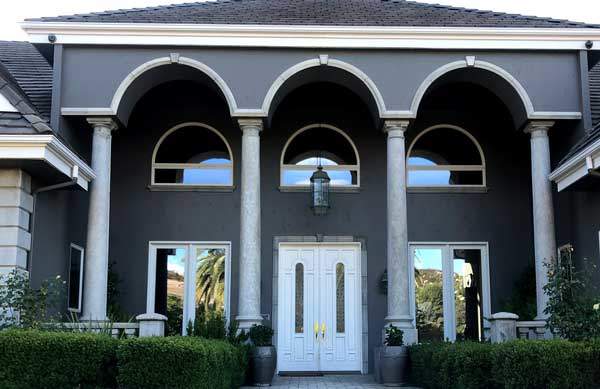Exactly How Residential Window Tinting Boosts Your Home's Energy Performance
Residential home window tinting provides an engaging solution for house owners seeking to boost energy performance within their living areas. By using specialized films to windows, it successfully lowers heat transfer, thus supporting interior temperature levels and decreasing the demand for excessive heating or cooling.
Understanding Window Tinting
Comprehending window tinting is necessary for home owners looking for to enhance both comfort and power performance in their space. Residential Window Tint. Window tinting involves the application of a thin film to the interior or outside surface area of glass home windows. This movie can substantially regulate the amount of sunlight and heat that enters a home, thus affecting interior environment conditions
There are different sorts of window tinting movies readily available, each with distinctive residential or commercial properties. As an example, dyed movies take in solar power, while reflective films disperse it far from the glass surface. Ceramic films supply an equilibrium of exposure and heat rejection, making them a preferred option among homeowners. The performance of home window tinting is frequently measured by its Visible Light Transmission (VLT) percent, which suggests just how much light can pass via the film.
Benefits of Energy Efficiency
Home window tinting not only improves aesthetic appeals but likewise plays a significant duty in improving power efficiency within household spaces. By lowering heat transfer via windows, colored films produce an extra stable interior environment, which can result in substantial reductions in energy intake for heating & cooling. This power efficiency equates right into lower utility costs, providing house owners with significant long-term cost savings.

In addition, home window tinting enhances the convenience of living rooms. By decreasing glow and blocking harmful UV rays, colored windows develop a more positive setting, which can lead to boosted health for owners. The security versus UV rays also aids preserve furniture and flooring from fading, adding to the long life of home items.
How Tinting Works
Tinting movies operate via a combination of innovative products and modern technologies developed to control the quantity of solar energy getting in a home. Mainly made up of polyester, these films often include ceramic or metallic fragments that absorb and show warmth. This double capacity allows them to dramatically reduce the infiltration of ultraviolet (UV) rays and infrared radiation while allowing visible light to go through.
The effectiveness of window tinting is determined by its solar warmth gain coefficient (SHGC), which indicates just how much solar power is transmitted with the home window. Lower SHGC values are more effective as they represent greater warm denial. Additionally, window tints can include a selection of shades, allowing house owners to tailor their visual preferences see this while enhancing energy performance.
Furthermore, these films function as an obstacle, protecting against heat loss throughout colder months by mirroring indoor heat back into the home. This thermal insulation effect matches the air conditioning benefits gained during warmer months, adding to a well balanced indoor climate year-round. By managing solar energy successfully, property home window tinting not just boosts convenience yet additionally plays an essential duty in lowering power intake and decreasing energy expenses.
Selecting the Right Tint

There are different kinds of home window movies available, including dyed, metalized, and ceramic. Ceramic films supply superb warmth control without compromising visibility and are very sturdy, making them a popular choice.
Noticeable light transmission (VLT) is another crucial factor, as it shows the quantity of natural light that can go through the tinted glass. House owners need to pick a color with a VLT that enhances their lighting preferences while still offering sufficient glare reduction.
Additionally, evaluating the solar heat gain coefficient (SHGC) can help determine how well a tint Visit This Link can obstruct warmth from sunshine. A lower SHGC indicates better warmth control, inevitably boosting energy performance.
Installation and Upkeep Tips
Proper installment and maintenance are crucial components in optimizing the benefits of property window tinting. Experts additionally use specialized methods and devices, which can enhance the toughness and performance of the tint.
Complying with installment, maintenance is necessary to prolong the life of the window movie. It is advised to wait a minimum of 1 month prior to cleaning up the tinted home windows to allow the adhesive to heal fully. When cleansing, use a soft fabric and a mild, ammonia-free cleaner to stay clear of damaging the movie. Stay clear of rough materials that can scrape the surface area.
Dealing with these issues promptly can prevent additional damages and maintain energy effectiveness. By adhering to these setup and maintenance pointers, house owners can guarantee their home window tinting continues to provide substantial energy savings and convenience for years to come.
Final Thought
In conclusion, domestic window tinting offers as a reliable solution for improving energy effectiveness within homes. By minimizing warmth transfer and blocking dangerous UV rays, home window films add to lower power consumption and enhanced interior comfort.
Window tinting entails the application of a thin film to the inside or outside surface area of glass windows. By decreasing warm transfer via home windows, tinted films develop an extra steady interior environment, which can lead to significant decreases in power intake for heating and air conditioning.The efficiency of home window tinting is measured by its solar warmth gain coefficient (SHGC), which indicates exactly how much solar power is sent with the window. By handling solar energy properly, domestic window tinting not just boosts comfort however Visit This Link additionally plays an essential role in decreasing power intake and reducing utility costs.
By minimizing heat transfer and obstructing unsafe UV rays, window movies contribute to lower power intake and improved indoor convenience.